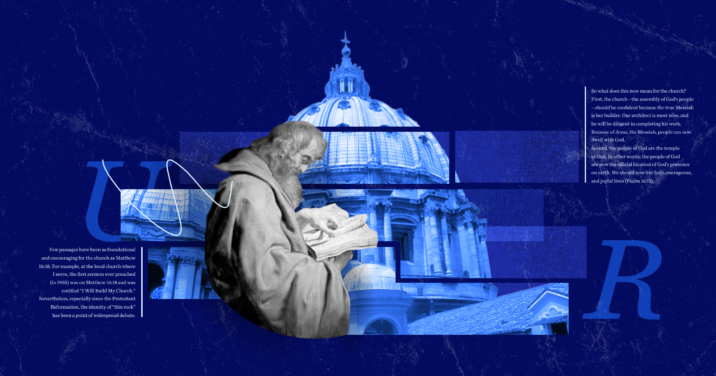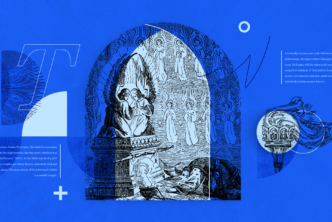Jesus says to Peter in Matthew 16:18,
You are Peter, and on this rock I will build my church and the gates of Hades will not overcome it.1
Few passages have been as foundational and encouraging for the church as Matthew 16:18. For example, at the local church where I serve, the first sermon ever preached (in 1955) was on Matthew 16:18, entitled “I Will Build My Church.” Nevertheless, especially since the Protestant Reformation, the identity of “this rock” has been a point of widespread debate. Roman Catholics have tended to interpret the rock as Peter, and Protestants have been inclined to assert that the rock is the confession or faith of Peter. Because of this ongoing debate, many other important aspects of the interpretation of this verse have been overlooked; for example, the temple connotations from the Old Testament and Second Temple Jewish Literature that permeate Matthew 16:18. Therefore, this article will explore how the Old Testament and Second Temple Jewish Literature can help us better appreciate the encouragement that is to be found for the church from Matthew 16:18.
While Jesus does not directly quote from any Old Testament passage in Matthew 16:18, his speech does use at least four temple themes known from the Old Testament and Second Temple Jewish Literature. These temple themes are the following:
- The Messiah as the true temple builder
- The assembly of the people of God as the temple of God
- The temple and rock connection
- The connection between the temple and God’s ongoing presence and protection of his people2
These temple themes in Jesus’ prophecy to Peter should greatly edify the saints as they continue to live as the holy and courageous people of God in this current age.
1. The Messiah as the true temple builder
The Hebrew noun “Messiah” (משיח) comes from the Hebrew verb for “to anoint” (משח), and the noun refers to one who has been anointed. In Greek, the corresponding noun is “Christ” (χριστός). Therefore, when Peter declares Jesus to be “the Christ” (ὁ χριστός) in Matthew 16:16, Peter is declaring Jesus to be the true Messiah. Many expectations can accompany a messiah in the Old Testament, and the typical anointed offices are a prophet (1 Chr 16:22; 1 Kgs 19:6), a priest (Num 3:3), and a king (1 Sam 26:9). Despite the occasional person who holds more than one of these offices (for example, David), these three offices often serve separate functions among the people of God in the Old Testament. However, despite these separate functions, it is not uncommon for each of these three offices to focus on one building in particular: the earthly dwelling of God’s presence. This focus is especially true for faithful, Davidic kings.
In 2 Samuel 7, the Lord links the house of David (i.e., the Davidic dynasty) with the house of the Lord (the temple). Therefore, the kings from David should especially care for God’s temple in Jerusalem because the dynasty’s ongoing reign is connected to the existence of the temple. This connection is one reason why the books of 1–2 Kings and 1–2 Chronicles highly commend kings for temple renovations (for example, 2 Chr 29) and for the removal of other locations of worship or idolatrous perversions (for example, 2 Kgs 23); conversely, these books also condemn kings who defile the temple (2 Chr 28) and pursue idolatry (1 Kgs 12–13). Peter clearly declares Jesus to be the Messiah in Matthew 16:16, and now the Messiah is beginning to build in Matthew 16:18.
But what type of building is the Messiah building in Matthew 16:18? The expected answer from the Old Testament is God’s temple. However, the text indicates that the Messiah is building an “assembly” (ἐκκλησία). At this point, a writing found in the Dead Sea Scrolls can provide insightful assistance.
2. The assembly of God as the temple of God
Many theories abound about the reclusive Jewish community at Qumran, which housed the Dead Sea Scrolls, but one thing is clear: this community did not have a very high opinion of the Jewish religious leaders at the temple in Jerusalem before and after the time of Jesus. So much so that they were willing to abandon the temple in Jerusalem altogether and make a home in the wilderness near the northwest region of the Dead Sea. How could God-fearing Jews abandon the temple in good faith? By developing an alternative temple theology—because, in their view, God had rejected the temple in Jerusalem.
The Community Rule (1QS) is a fascinating document found at Qumran; it seems to be a charter document of sorts for the community. For Matthew 16:18, specifically, one passage from the Community Rule holds great pertinence. It reads,
The council of the community will be established in truth … to be a lasting planting, a house of holiness for Israel and a foundation of the Holy of Holies for Aaron. (1QS VIII, 5–6)
While the community at Qumran was awaiting a true, physical temple (with sacrifices) in the future, in the meantime they understood their community to be a substitute dwelling place of God. The phrases “a house of holiness for Israel” and “a foundation of the Holy of Holies for Aaron” are laden with unmistakable temple imagery.3 In other words, a community of God-fearing Jews—or at least the ruling council of this community—can view themselves as an acceptable temple of God, in contrast to a physical building in Jerusalem in the first century.
Therefore, in Matthew 16:18, when the Messiah says that he is building an “assembly” (ἐκκλησία), it clarifies two things:
- The Messiah views the physical temple in Jerusalem as insufficient and eclipsed.
- This Messiah will be establishing a community that will be the new holy dwelling of God.
These temple connotations for this new community are strengthened by where the Messiah will be building them: on a rock.
3. The temple and rock connection
The most discussed part of Matthew 16:18 is the location of the Messiah’s building project: “On this rock.” Three primary views have been espoused for the identification of this rock: faith, Peter, or Christ. Before the Reformation and Roman Catholic reactions to it, some interpreters believed that the rock of Matthew 16:18 was actually Christ.4 Much earlier, however, Origen interpreted the rock as everyone who has faith upon the Rock of 1 Corinthians 10:4 and imitates him.5 Alternatively, based upon the rather transparent wordplay in Greek, Jerome views the rock (πέτρα) as Peter (Πέτρος).6 A majority of biblical scholars, both Catholic and Protestant, now interpret the rock as Peter, based upon this Greek wordplay—although the same cannot generally be said of Protestant preachers.7 Peter is the rock in Matthew 16:18; however, he is only the rock when his faith is in the Messiah and the Messiah’s plan (Matt 16:21).8 Otherwise, Peter is a stone of stumbling (Matt 16:22–23) and rocky ground (Matt 13:5–6, 20–21); indeed, he is a “Satan” that Jesus rebukes (Matt 16:23).9 Lost in much of the above discussion, however, is the strong connection between the temple and a rock throughout the Old Testament.
The temple connection with rock imagery is interconnected and twofold in the Old Testament:
- The location of the temple is on a rock.
- The enduring quality of a rock is projected onto the temple.
A refuge on a high rock is considered a “safe place” in the Old Testament. This imagery for safety derives from a variety of different factors:
- The inaccessible nests of eagles on high clefts (Job 39:27–30; Deut 32:11).
- The added difficulty of conquering elevated fortresses in battle in the ancient world.
- The fact that Jerusalem is located on a hill (Pss 15:1; 24:3).
For example, in Psalm 27:4–6, the psalmist earnestly desires to dwell in the house of the Lord, and safety is a positive consequence of being in the Lord’s presence. Most pertinently, in Psalm 27:5b, the following two actions of the Lord are placed in parallel phrases:
[The Lord] will hide me in the hiding place of his tent;
on a rock he will exalt me.
Here, the psalmist equates being safe in the hiding place of God’s dwelling with being placed on a high rock. Similarly, in Psalm 61:1–4, the psalmist combines the imagery of the Lord’s house, a high rock, and an eagle. The psalmist desires to dwell on an exalted rock (Ps 61:2) because—among other reasons—in the Lord’s tent he will find refuge in the hiding place under the Lord’s wings (Ps 61:4). The one who is welcomed into God’s presence will also “dwell on the heights,” and “his refuge will be strongholds of rocks” (Isa 33:14–16).10
Along with the above “rock” (צור) imagery, “stone” (אבן) imagery is also used for the temple in the Old Testament (Isa 28:16). In Daniel 2:35, a “stone” (אבן) becomes a great “rock” (טור) that fills the earth and represents a kingdom that endures forever (Dan 2:44–45).11 In a book that longs for a return to the Lord’s dwelling in Jerusalem (Dan 6:10; 9:2) and to the sanctification of the Lord’s house and its sacrifices (Dan 8:13–14, 26; 9:17–27; 12:11–12) and its holy vessels (Dan 1:2; 5:2–4, 22–23), this great rock (Dan 2:35) can also be understood to refer to the Lord’s temple. The Lord’s presence at his temple will ensure that this kingdom will last forever (Dan 2:44–45). A “rock” is very good place for the Messiah to build (Matt 16:18).
4. The connection between the temple and God’s presence and protection of his people
Examples abound throughout the ancient Near East, including in the Old Testament, of kings either building temples or renovating an important temple towards the beginning of their respective reigns. For example, Solomon begins to build the temple in the fourth year of his reign (1 Kgs 6:1) and Hezekiah begins to renovate this same temple in the first year of his reign (2 Chr 29:3).12 These kings desire divine protection, and establishing a temple signifies that a deity protects the king and his kingdom. Thus, the following thought is commonplace: as long as our temple is standing, our enemies stand no chance, because a deity is with us. This idea is especially true for faithful kings from the line of David because of the Lord’s promises in 2 Samuel 7 (see above). Therefore, Jeremiah prophecies, “Do not let yourselves trust in the these words of falsehood: ‘The temple of the Lord, the temple of the Lord, the temple of the Lord’” (Jer 7:4). In other words, the people of Jerusalem were looking to the temple for their security; however, the Lord was about to leave his house because of the people’s unfaithfulness and injustice. Similarly, in Ezekiel 10–11, the Lord departs from the temple; Jerusalem will now surely fall (Ezek 24), and a new temple is the closing hope and prophecy (Ezek 40–48) with a new Davidic leader (Ezek 37:24).
Finally, after many years, the Davidic Messiah is building an assembly on a rock (Matt 16:18). That is to say, the Messiah is building a new temple on a rock. The gates of Hades—and any other opposition—will stand no chance.13 God will be with his people (Matt 1:23), and the Lord (and Messiah) will be victoriously present with his people henceforth (Matt 28:18–20). The people of God—who are now the temple of God with the presence of God—have every reason for holiness, courage, and hope.
Conclusion: What “Upon This Rock I Will Build My Church” Means for the Church
Matthew 16:18 contains the following temple themes from the Old Testament and Jewish Literature:
- The Messiah as the true temple builder
- The assembly of the people of God as the temple of God
- The temple and rock connection
- The connection between the temple and God’s ongoing presence and protection of his people
So what does this now mean for the church?
First, the church—the assembly of God’s people—should be confident because the true Messiah is her builder. Our architect is most wise, and he will be diligent in completing his work. Because of Jesus, the Messiah, people can now dwell with God.
Second, the people of God are the temple of God. In other words, the people of God are now the official location of God’s presence on earth. We should now live holy, courageous, and joyful lives (Ps 16:11).
Third, the people of God are built upon a rock. The Lord used Peter (and the apostles) to give foundational teachings for salvation, and the church should always live by the apostles’ teaching found in Scripture (Acts 2:42).14 The church should never seek a foundation in the shifting winds (Eph 4:14) and philosophies (Col 2:8) of our culture; rather, its foundation should be on the “rock” (Matt 7:24–25) of the teaching of Christ (and his apostles) and obeying it.
Fourth, and finally, being the temple of God means that the people of God are protected by God himself and that God will be victorious. Although the people of God will die in this life, they will not die before God allows. As their Messiah, their deaths will never be in vain (Rev 14:12–13). They will be living sacrifices (Rom 12:1), and God will work good through them that will overcome evil (Rom 12:21). Satan will be crushed under their feet (Rom 16:20), and the gates of Hades will be defeated (Matt 16:18). Therefore, the church should always be on mission because the Lord will be with them (Matt 28:18–20).
Related articles
- What Is an Evangelical Church?
- How to Develop a Culture of Bible Study in Your Church
- Beyond “A People, Not a Place”: What the Church Really Is
Resources to continue studying “upon this rock I will build my church” (Matt 16:18)
- All translations are my own unless otherwise specified.
- For additional information, see Timothy M. Rucker, The Temple Keys of Isaiah 22:22, Revelation 3:7, and Matthew 16:19: The Isaianic Temple Background and Its Spatial Significance for the Mission of Early Christ Followers, WUNT 2.559 (Tübingen: Mohr Siebeck, 2021), 144–57. Much of this blog article is (necessarily) indebted to the above monograph.
- Also, see 1QS V, 5–6; 1QS VIII, 8–10; 1QS IX, 3–6; 1QpHab XII, 3–4.
- For the “monolithic” Roman Catholic interpretive shift towards Peter, see John E. Bigane III, Faith, Christ, or Peter: Matthew 16–18 in Sixteenth Century Roman Catholic Exegesis (Washington, DC: University Press of America, 1981), 199.
- Origen, Comm. Matt. 12.11, which is where his commentary on Matthew 16:18 is located. Since Origen links Matthew 16:18 with 1 Corinthians 10:4, it is easy to see how interpreters began interpreting the “rock” of Matthew 16:18 as Christ himself.
- Jerome, Commentary on Matthew, TFOC 117, ed. Thomas P. Halton, trans. Thomas P. Scheck (Washington, DC: Catholic University of America Press, 2008), 192.
- In my own personal experience in Protestant churches, a majority of preachers still view the rock as Peter’s faith. A relatively recent scholarly exception, which argues for Peter’s faith/confession, is Chrys C. Caragounis, Peter and the Rock, BZNW 58 (Berlin: de Gruyter, 1990).
- Note how the Lord later uses Peter to open doors and lay the foundation for salvation for Jews (Acts 2), Samaritans (Acts 8), and Gentiles (Acts 10).
- Mark Goodacre, “The Rock on Rocky Ground: Matthew, Mark and Peter as Skandalon,” in What Is It That the Scripture Says?: Essays in Biblical Interpretation, Translation, and Reception in Honour of Henry Wansbrough OSB, ed. Philip McCosker, LNTS 316 (New York: Continuum, 2006), 61–73.
- For additional discussion of this passage, see Rucker, Temple Keys, 66–72.
- Note that Daniel 2:35–45 is part of the Aramaic portion of Daniel and that the Aramaic word טור (“rock”) is the Aramaic cognate to the Hebrew word צור (“rock”). In addition, similar “mountain” (הר) imagery is also used for the temple in the Old Testament; for example, see Isaiah 2:1–5.
- For an extrabiblical example—among many—from the ancient Near East, see the Hittite text “Ritual for the Erection of a House” (ANET 356).
- For the view that the gates of Hades refers to evil powers, see Joel Marcus, “The Gates of Hades and the Keys of the Kingdom (Matt 16:18–19),” CBQ 50 (1988): 443–55. In addition, in the phrase, “The gates of Hades will not overcome it,” the “it” could grammatically refer to the “assembly” or to the “rock.” The “assembly” is the most likely (and closest) referent, but both could be implied due to the close association between the rock and the assembly.
- Many interpreters have viewed Matthew 16:19 as referring to the teaching ministry of Peter, and many have seen an extension of Peter’s initial influence to include other disciples in Matthew 18:18.







